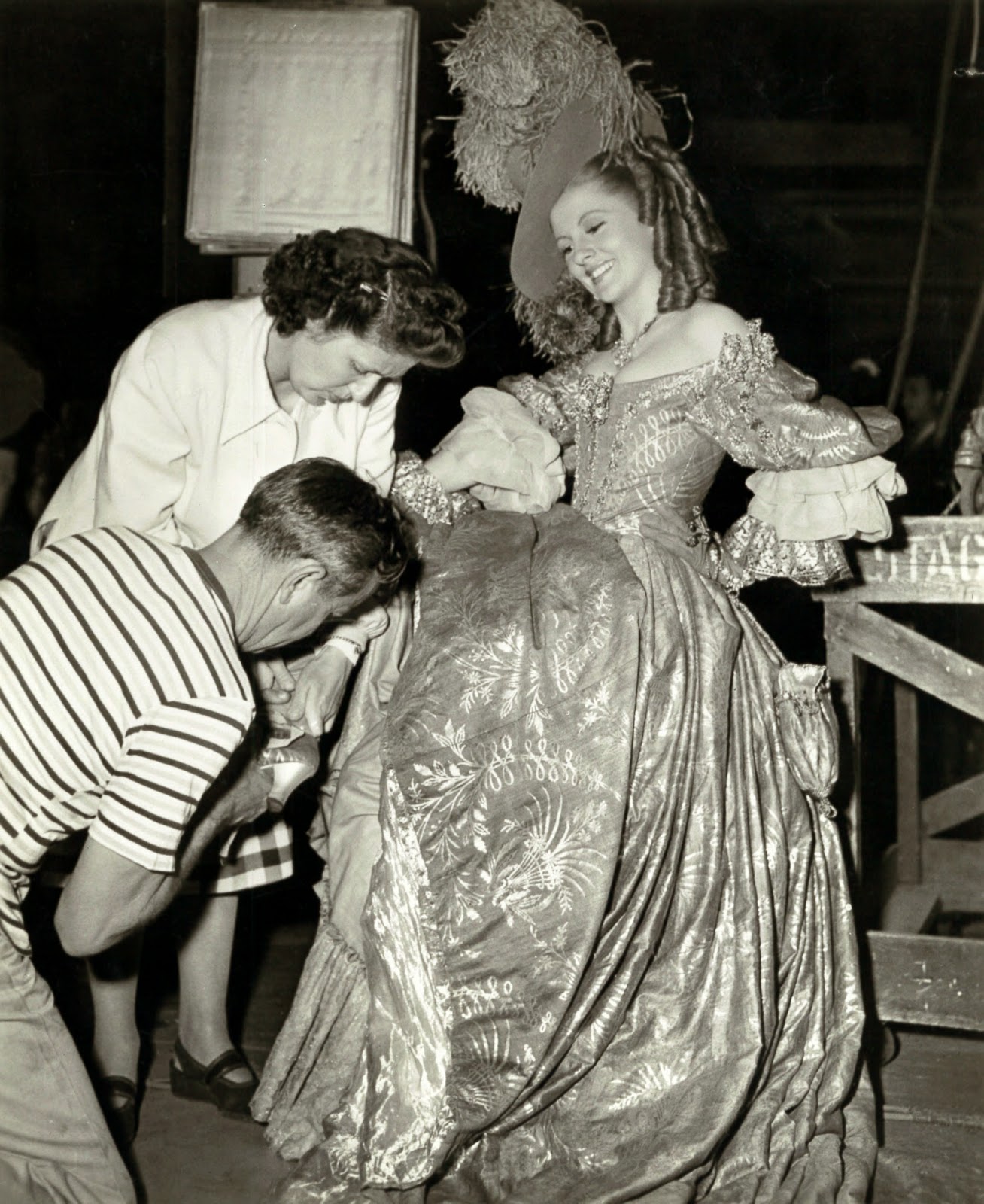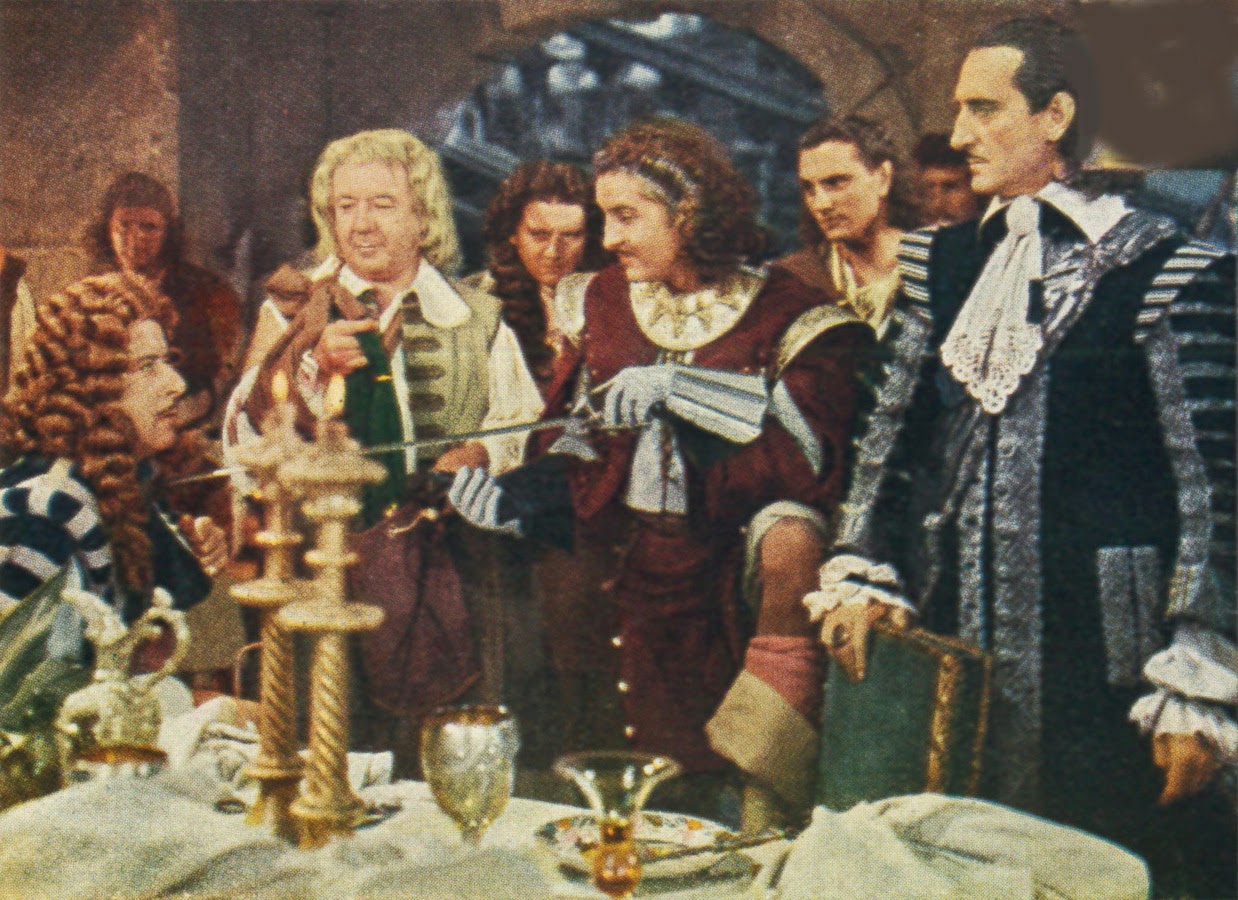When Pirates Couldn't Take A Censor's Stronghold
 |
| Chicago In Context: These Were The Big Shows Playing Through Yule '44 and Into a New Year |
Frenchman's Creek In Your 1944 Christmas Stocking --- Part Two
It's Christmas 1944, and you're going to the show. Each of companies is out with shiniest baubles. Warners had To Have and Have Not plus Hollywood Canteen in fresh release, while Metro premiered National Velvet at
 |
| A Pirate Ship Built Twice: At Top Full-Scale, and Below a Para-Built Miniature |
Arturo DeCordova speaks the cleansing line to Joan Fontaine: "Of course, if you choose to stay in
 |
| Movie Magic! Everything Above Players is Matte-Painted |
 |
| A First Floor Is Built, The Rest a Hanging Miniature |
The process of star creation, and how it sometimes failed, can be seen up close in Frenchman's Creek, its launch of Arturo DeCordova being a craft that sank within the year
Further down cast listing was Harald Ramond, another who might have made the grade but for ugly scandal that rendered him persona non grata just as Frenchman's Creek was widening out for 1944's holiday season. Ramond had emigrated to the
And so we're left with what Universal gives us of Frenchman's Creek. Maybe there's a 35mm nitrate print surviving somewhere, but I've doubt of ever seeing it, short of seven hour's flight to a UCLA or some such screening. I know my own affection for this show is perverse. Ladies in forty-pound costumes, men bewigged with poodle dogs travelling in wake. Joan Fontaine's fop of a husband says "Fiddle-Dee-Dee" repeatedly. The pirates don dresses and captured corsets and kiss each other. To quote Paul Cavanagh's deathless putdown from The Mississippi Gambler, "they handle a sword as though it were a parasol." But then there is Basil Rathbone, a lion among lambs. And what fun to see he and Nigel Bruce sharing scenes in this folderol, and right in midst of Holmes-ing it at Universal (breaks on Frenchman's location found the two recording SH radio broadcasts). Wrath-bone shuns the wig when it's time to get dangerous, like when he does rape attempt on Joan. That's the wildest scene in Frenchman's Creek and worth an hour and half's wait. As with The Mark Of Zorro, once Basil's dispatched, the show is essentially over. Everything after that (another thirty minutes of Frenchman) is badly anti-climactic. Still, Frenchman's Creek is loads of fun and priceless mirror to what flipped audiences in late '44 and right thru '45, a monster hit of its day that I'm glad to see available to us now.










14 Comments:
I'm still not sure if you've succeeded in making me curious enough to actively track this one down, but this was an excellent write-up.
Thank you for the mention of Harald Ramond. The only thing I knew about him was the concurrent Lupe Velez affair, so I appreciate your placing him in context.
Arturo DeCordova was a terrific actor, although in the majority of his movies he always plays the part of guy attempting a revenge against those who had damaged him. Although he was a big star in Mexico, his greatest film was the Argentine production called DIOS SE LO PAGUE (1948) that was even released in the United States and was even distinguished by AMPAS. It is a melodramatic fantasy (it can be seen in YouTube)whose main premise is actually extremely funny.
In today's banner, poor Rathbone looks like a cocker spaniel.
Great two-part article. But I'm confused, and it's probably poor reading skills on my part, but IS this available on Disc or on pay-tv? You mentioned Universal...is that a cable channel or a dvd?
Thanks,
Ken
"Frenchman's Creek" is available via Universal's On-Demand Vault Series on DVD-R, and can be acquired through Amazon.
Thanks! It's been ordered!
Selznick was fast with numbers, but supposedly this was the most expensive movie ever made (certainly the most expensive of the war years) up to that time. Did it look it, do you think?
It's a lavish and beautiful production --- all of money looks to be right up there on the screen.
Oops, I don't know why I mixed Selznick in there, other than the passing reference.
I know both Wilder and Preston Sturges disliked Leisen, but as far as I'm concerned what he did with their scripts for Midnight and Easy Living respectively is as good as anything they ever did with their own words. And Easy Living has a sequence close enough to one in Palm Beach Story (when the respective female stars tour apartments, wordlessly) that it's clear Sturges learned from him, even if he didn't like him.
Wow, thank you John, a terrific pair of posts on a film I knew next to nothing about...
Dan Mercer shares some fascinating insights into "Frenchman's Creek" (Part One):
"Frenchman's Creek" is by no means a bad movie. The settings and costumes are sumptuous, the Technicolor photography gorgeous, and there is a keen visual sense which sometimes suggests what the screenplay ought to have provided. Joan Fontaine looks as beautiful as she ever would in a film, but the wigs worn by many of the men in the picture rival her own. There is an ambivalent sexuality which may appeal to some, but it is at the expense of real passion or drama, while such moments of brilliance as there may be are like sparks which find no tinder. Thus I would regard it as a pleasant diversion for an afternoon, but little more.
Joan Fontaine had not wanted to make it, for reasons that are understandable. She was coming off a remarkable run of films over three years, with "Rebecca" and "Suspicion" for Alfred Hitchcock, then "The Constant Nymph," "This Above All," and "Jane Eyre." Besides Hitchcock, she had worked with directors Edmund Goulding, Anatole Litvak, and Robert Stevenson. Her leading men had been Laurence Olivier, Cary Grant, Charles Boyer, Tyrone Power, and Orson Welles. She had won the Academy Award for Best Actress and been nominated on two other occasions.
This production must have seemed quite a come down, for all its expense and prestige. The screenplay was, as you say, a "bodice ripper," stilted and arch. The director, Mitchell Leisen, was technically accomplished, but better known for musicals and comedies. And then there was her leading man, in the person of the diminutive Mexican star, Arturo de Cordova. His performance would prove to be not without interest, but far from what was required, if the story was to be taken seriously. There is never a sense of genuine attraction between him and his leading lady, let alone love, nor is there that expression of the sort of honor which is passion's champion. Errol Flynn, of course, set the standard for that sort of chivalry, though Tyrone Power offered a worthy alternative in "The Black Pirate," somewhat rougher but nonetheless a hero seeking the hand of his lady. De Cordoba can follow neither example nor make his own way. Instead, there is a frenetic, artificial quality to his performance, all teeth and nostrils and waving hair. He is a comic opera pirate, suitable perhaps for a subordinate role while we wait, in vain, for the authentic star to appear.
The screenplay by Talbot Jennings, who had also worked on "Mutiny on the Bounty" and "Northwest Passage," was reasonably faithful to the Daphne du Maurier novel in incident, but not in theme. Du Maurier's overt sexuality, of course, could have no direct counterpart in the film, but other aspects might have received greater emphasis. Fontaine thought that it would be much better if it treated the lady and her pirate as ill-fated lovers. She even thought that filming it in black-and-white rather than Technicolor would be more suitable for such a mood piece. No doubt she had "Jane Eyre" in mind, which had succeeded wonderfully in that regard despite the distractions of a contentious Orson Welles. For Paramount, however, Technicolor was an essential safeguard for such a huge investment, but if it was more interested in a rollicking adventure-story, rather like "The Black Swan," which was also filmed in that process, what resulted was one curiously devoid of action, though not of sexuality, at least of a sort. There is, for example, a curious scene in which pirates cavort about their ship in drag, adorning themselves in corsets and other dainties of the ladies, while de Cordova seems to prefer Fontaine in male guise. Possibly the problem was that there was more swish than swash in the tale as it was filmed.
Part Two from Dan Mercer:
Fontaine's misgivings could not be allayed, but she was under contract to David O. Selznick, whose income during this period was largely derived from loaning his stars out for the productions of other studios. With his massive personal expenses and huge gambling debts, he could no longer be as choosy in what he allowed them to do. Paramount would pay him twice her salary, with the difference going into his frequently empty pocket. He pressured her to take the role, threatening suspension if she did not but promising her more money and to intervene to have the faults in the script and production corrected.
To his credit, Selznick did try, loosing an imposing barrage of memos in his own inimitable style, until at last the studio, as you noted, told him either to desist or to leave and to take his girl with him. There is a question what the Selznick of five years before would have done, but the present version was strung-out and living on appearances. He gave way and Joan Fontaine was left on her own. She already resented him for having cost her the role of the young Charlie in "Shadow of a Doubt"--the early treatments referred to "the Joan Fontaine character," but Hitchcock, who was also under contract to Selznick, remembered the "Rebecca" production and simply wouldn't suffer that kind of interference again, ultimately choosing Theresa Wright for the role--and his abandoning her now to a film which was sure to be critically disappointing, if not a failure, was more than she could bear. When her contract expired, she would go her own way.
Despite he unhappiness with the production, however, there are occasions when Fontaine gives a fully realized performance, as though understanding the sexual frustration of woman who has been married out of social necessity but not for love or romance. Her scenes with Basil Rathbone are erotically charged in a way none of those with de Cordova are, so much so that a very different picture might have resulted, had he been the lead. The frenzied hysteria of the ending, with Rathbone stalking a desperate Fontaine, determined to have his way with her, as her children wail in terror, is genuinely exciting. It does not save the picture, not quite, but it at least makes the long wait worthwhile.
I hope you have heard that the story of the death of Lupe Velez is in fact, an urban myth--she did NOT drown in the toilet.
Paul Duca
Post a Comment
<< Home